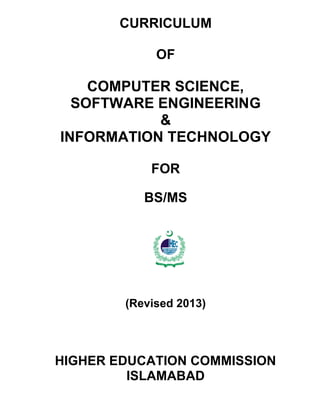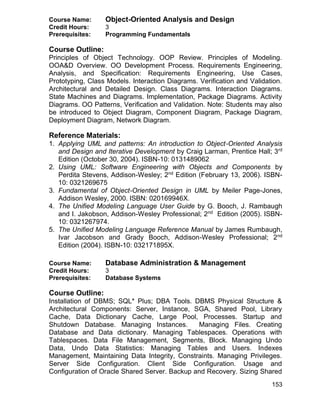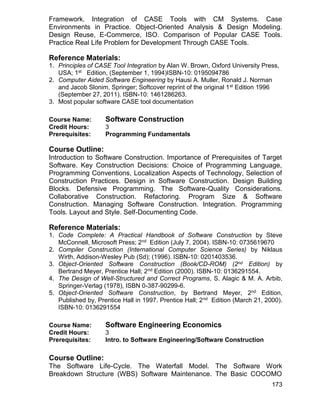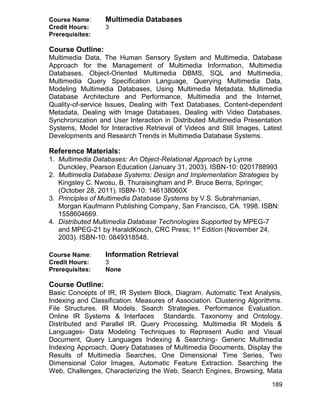The document outlines the curriculum for a Bachelor of Science in Computer Science (BS CS) program. It proposes a program structure with 130 total credit hours distributed across core computing courses, computer science courses, general education courses, and university electives. The computer science courses are further divided into core courses, supporting courses, and electives. Some key areas covered in the computer science electives include networking, information management, intelligent systems, graphics and visualization, software engineering, web engineering, e-commerce, multimedia, distributed computing, security, languages and translators, computer architecture, systems software, scientific computing, and soft computing. The committee revised the curriculum to reflect recent developments in technology and prepare graduates for the future.









































































![74
engineering practice and with the underlying concepts and principles of
computer science. It requires facility in problem analysis, solution design,
program development and documentation. It also requires a basic
understanding of the ways in which humans interact with technological
systems.
A software engineering programme should develop professionals who have a
mastery of software development principles, theory, practice, and process.
Software Engineering and Computer Science differ in much the same way as
do Electrical Engineering and Physics1
. Generally, engineering should be
concerned with applying what we already know to create products, while
science is more theoretical. Therefore, the goal of Computer Science,
according to Parnas2
, is to learn and to extend the science. SE on the other
hand aims to use the science and technology already available to create
products and tools for use.
Software Engineering derives its essence from computer science as other
engineering disciplines do from natural or life sciences, with an emphasis on
issues of process, design, measurement, analysis and verification providing a
strong foundation in engineering principles and practices as applied to
software development.
Definition:
Software Engineering is a discipline concerned with the development of
software systems by applying engineering principles with the goal of
developing cost-effective quality systems. There are many definitions in
literature. Such as:
"The establishment and use of sound engineering principles
(methods) in order to obtain economically software that is reliable
and works on real machines" [Bauer 1972].
"Software engineering is that form of engineering that applies the
principles of computer science and mathematics to achieving cost-
effective solutions to software problems." [CMU/SEI-90-TR-003]
"The application of a systematic, disciplined, quantifiable
approach to the development, operation, and maintenance of
software" [IEEE 1990].
1
David Parnas, “Software Engineering Programmes are not Computer Science
Programmes”, IEEE Software, Nov/Dec. 1999, pp. 19-30.
2
David Parnas, “Software Engineering Programmes are not Computer Science
Programmes”, IEEE Software, Nov/Dec. 1999, pp. 19-30.](https://image.slidesharecdn.com/bsandmscomputerscience-190109154406/85/Bs-and-ms-computer-science-74-320.jpg)
![75
IEEE defines software engineering [IEEE-93] as
“1. The application of systematic, disciplined, quantifiable
approach to development, operation, and maintenance of
software; that is application of engineering to software.
2.The study of approaches as in 1.”
Software Engineering could also be defined as:
“The application of systematic, disciplined, quantifiable approach to
design, development, deployment, and maintenance of reliable and
economical software systems.”
Vision:
Software engineering is the discipline of creating high-quality software
systems in a systematic, controlled and efficient manner. It involves the
application of engineering concepts, techniques, and methods to the design,
development, deployment and maintenance of software systems. A software
engineering programme should develop professionals who have a mastery of
principles, theory, practices, and processes necessary to produce quality
software systems. The curriculum committee formalized the Vision Statement
for SE education in Pakistan as follows:
The SE education in Pakistan will focus on imparting the knowledge and
training which should enable students to harmonize theory with practice,
concept with application, and problem with solution. It will prepare them to
apply ably engineering principles, practices, and processes to design,
develop, deploy, and maintain software systems. The programme will lead
to development of student’s professional and interpersonal skills. It will
help students to enhance their ability in oral and written communication,
and their adaptability to team environments. The programme will inculcate
among students a strong sense of civic, professional and ethical
responsibility. The programme will also strive to develop a capacity for
innovation and a passion for lifelong learning.
SE curricula thus developed would reflect the aim to satisfy professional
demands of the industry and academia both in terms of immediate needs and
the capacity for longer term development. The graduates thus produced will
be adequately equipped to exploit the opportunities and answer the
challenges offered by the modern world.
Knowledge Areas of SE Curriculum Development ABET Engineering Criteria
2000 notes:
“The curriculum must provide both breadth and depth across the range of
engineering and computer science topics implied by the title and objective of](https://image.slidesharecdn.com/bsandmscomputerscience-190109154406/85/Bs-and-ms-computer-science-75-320.jpg)






































![114
8. Dr. Muhammad Khalid Badini
Chairperson
Department of CS & IT UoB Quetta, Pakistan
Member
9. Dr. Asfandyar Khan,
Assistant Professor/Chairman,
Department of Engineering,
Institute of Engg & Computing Sciences,
University of Science & Tech, Bannu.
Member
The National Curriculum Revision Committee for Information Technology
(NCRC-IT) met at HEC Regional Office Lahore on meet again on 10th
to 12th
June, 2013 and finalized the curricula recommendations. The experts
attended were same as in the first meeting.
The Discipline of Information Technology
According to ACM Curricula 20056
: “Information Technology” is a label that
has two meanings. In the broadest sense, the term information technology is
often referred to computing. Furthermore, it also refers to undergraduate
degree programs that prepare students to meet the computer technology
needs of business, government, healthcare, schools, and other kinds of
organizations. Curriculum Guidelines for Undergraduate Degree Programs in
Information Technology (2008) explains that “Information Technology (IT) in
its broadest sense encompasses all aspects of computing technology. IT, as
an academic discipline, is concerned with issues related to advocating for
users and meeting their needs within an organizational and societal context
through the selection, creation, application, integration and administration of
computing technologies.” Figure 17
, depicts the key pillars of academic
discipline of Information Technology
Information Technology as an
academic discipline, as defined by The
Information Technology Association of
America (ITAA), is “the study, design,
development, application,
implementation, support or
management of computer-based
information systems, particularly
software applications and computer
hardware”. It deals with the use of
electronic computers and computer
software to securely convert, store,
protect, process, transmit, input, output, and retrieve information. [Wikipedia]
Figure 1:Key Pillars of IT
6 Computing Curricula 2005: The Overview Report, IEEE and ACM Press.
7Curriculum Guidelines for Undergraduate Degree Programs in Information Technology (2008)](https://image.slidesharecdn.com/bsandmscomputerscience-190109154406/85/Bs-and-ms-computer-science-114-320.jpg)





































































![184
2nd
Edition (November 22, 2004). ISBN: 0131918354.
3. CCNA Wireless Official Exam Certification Guide by Brandon James
Carroll, Cisco Press; 1st
Edition (November 2, 2008). ISBN-10:
1587202115
4. Wireless Crash Course by Paul Bedell, McGraw-Hill Professional; 3rd
Edition (September 5, 2012). ISBN-10: 0071797890
5. Wireless and Mobile Data Networks by Aftab Ahmad, Wiley-Interscience;
1st
Edition (July 20, 2005). ISBN-10: 0471670758
Course Name: Advanced Web Systems & Technologies
Credit Hours: 3
Prerequisites: Web Engineering
Course Outline:
The Need for Web Engineering. Web Effort Estimation. Web Productivity
Measurement and Benchmarking. Web Quality. Web Usability. Web System
Reliability and Performance. Web Application Testing. Process Improvement
in Small Settings. Conceptual Modeling of Web Applications. Model-Based
Web Application Development. W2000: A Modeling Notation for Complex
Web Applications. Statistics Analysis. W3C Web Content Accessibility
Guidelines. Internationalization. Classroom Group Assignments: Instructors
are advised to ask students to review the Current Status of W3C
Specifications: HTML5, CSS3, Best Practices for Authoring HTML5, Web
Fonts, SMIL, Media Access, Timed Text, SVG, Web Real Time
Communication, Audio, Mobile Web Authoring, Device Independence
Authoring, CSS Mobile, SVG Tiny, XHTML For Mobile, Mobile Web
Applications, Mobile Web for Social Development, Geospatial, Accessible
Rich Internet Applications (WAI-ARIA), DOM, DOM events, Declarative Web
Applications, JavaScript APIs, Mobile Web Applications, WICD, Widgets,
XBL, Web Components, Web Performance. Google Technologies. Web 2.0 &
Associated Technologies.
Classroom Group Assignments: Instructors are advised to ask students to
review the Current Status of W3C Specifications: HTML, CSS, Best
Practices for Authoring HTML, Web Fonts, SMIL, Media Access, Timed Text,
SVG, Web Real Time Communication, Audio, Mobile Web Authoring, Device
Independence Authoring, CSS Mobile, SVG Tiny, XHTML For Mobile, Mobile
Web Applications, Mobile Web for Social Development, Geospatial,
Accessible Rich Internet Applications (WAI-ARIA), DOM, DOM events,
Declarative Web Applications, JavaScript APIs, Mobile Web Applications,
WICD, Widgets, XBL, Web Components, Web Performance. [W3C website]
Reference Materials:
1. Web Engineering by Emilia Mendes and Nile Mosley, Springer; Softcover
reprint of hardcover 1st
Edition. 2006 edition (November 9, 2010). ISBN-
10: 3642066453](https://image.slidesharecdn.com/bsandmscomputerscience-190109154406/85/Bs-and-ms-computer-science-184-320.jpg)

















